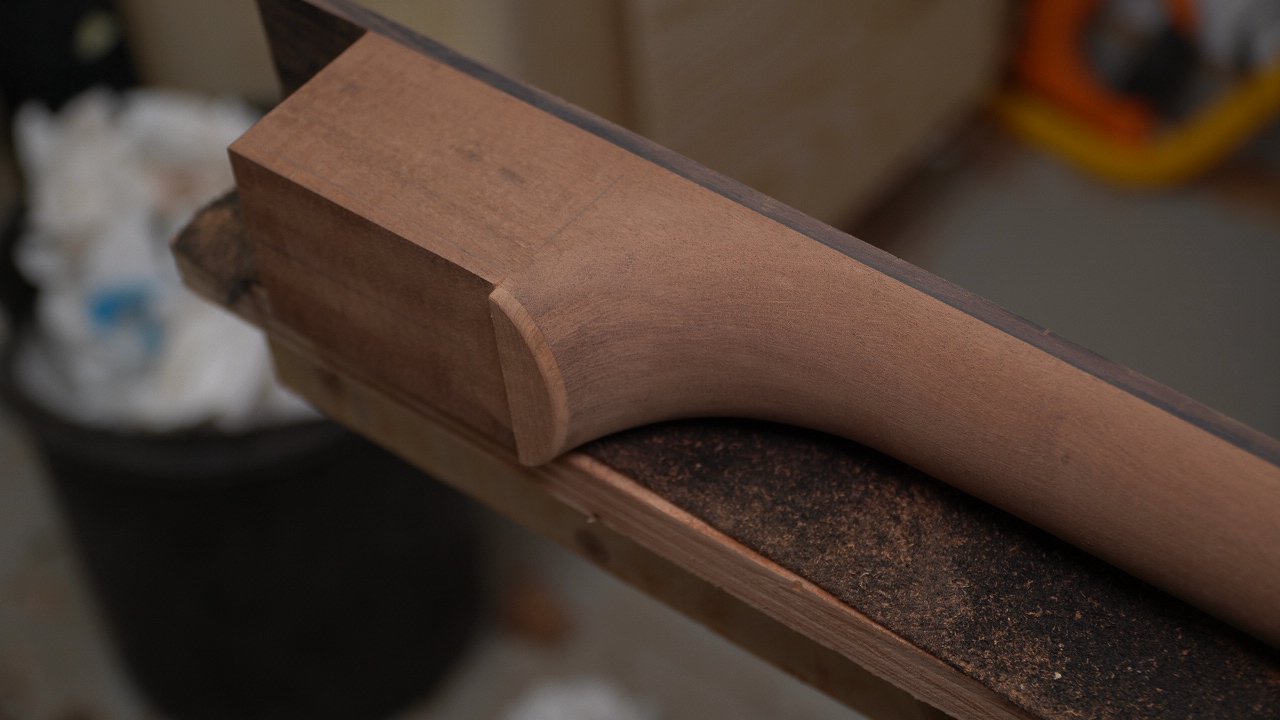In this chapter, you will find a selection of my best lutherie, including photos and descriptions of the materials and techniques used to create each piece. I am dedicated to using the finest materials and upholding traditional techniques to create instruments that not only sound great but are also visually stunning!
First Guitar - Scrapcaster
-
Due to the lockdown, I needed another hobby, and since I've been playing guitar for over 18 years, I thought why not build my own guitar! And since the Telecaster is my favorite shape, I grabbed a piece of scrap plywood and a glued oak board and started without any plan! I took my favorite guitar and transferred its shape onto the plywood board. I knew this would not be a masterpiece, but still, I just started and began cutting out the individual parts. When I realized that I needed a bit of experience for making the neck, I decided to buy a pre-made guitar neck. This worked out great and so, a week later, I had a functional guitar! Since I know what a very good guitar feels like, I knew that this was not my last guitar because I still had high potential for improvement here. So I searched for dimensions, materials such as tonewoods, and hardware that would be suitable for my next guitar!
-
Top: Plywood
Body: Glued Oka Panel
Neck: Maple (bought)
PickUp Ring: Ebony
Second Guitar - TELE I
-
Once I had found the materials, dimensions, and hardware, I decided to make the same shape as my test try. This shape was easy to build and did not require many tools! This time, I used Black Limba for the body and Walnut as the top wood. I decided to make the body of the guitar hollow to save weight, which is good for playing comfort. I ordered the neck online again because I still did not dare to make the neck myself. This guitar played much better and also gave a better sound than my first attempt.
-
Top: Walnut
Body: Black Limba
Neck: Maple (bought)
Third Guitar - VARION
-
For my third guitar, I wanted to try out a different classic shape. I chose the LesPaul. I used original plans from a well-known manufacturer. I used mahogany for the body and maple as the top. Additionally, I decided to build the neck of the guitar from an old table leg that I found in my friend's basement. This table leg was also made of mahogany and thus matched the color of my guitar body. The fretboard is made of rosewood, which requires the highest precision, so I bought this pre-made from a guitar store. So, already a part of the neck was self-made. This guitar also played very well, but was very heavy, as in contrast to the second guitar, the body is thick and solid. Therefore, I decided to build another guitar in the Telecaster style, but to finalize it with very special woods and a self-made neck.
-
Top: Flamed Maple
Body: Kaya Mahogany
Neck: Mahogany
Back Stripe: Maple
Fourth Guitar - VERITY
-
I didn't know which woods would offer a nice contrast together. So I made a rough 3D model and set various different woods as a texture. I decided on flamed maple and mahogany. I wanted the guitar to stand out not only because of its beautiful woods but also to include some design elements. I designed my own headstock shape and decided to replace the classical F-hole with a bow made of triangles. On the back, I made a continuous maple inlay that ran the entire length of the guitar. I designed my own logo and decided to inlay it into the fingerboard. I added the SVN initials with a water slide decal on the headstock. This was the first time I promoted the guitar under the name SVN-Guitars.
-
Top: Olive Ash
Body: African Walnut
Neck: African Walnut
Headstockplate: Maple
Accent Stripe: Maple
Fifth Guitar - VARION Hollow
-
So I now needed a first model that is not a copy but has its own shape. I decided on a combination of the most common guitar models and the lightweight of an acoustic guitar and I decided to make a new headstock design, as the previous one did not appeal to me in combination with the new shape. I kept this all in a CAD drawing and this way could rely on my measurements during construction. Additionally, I optimized the position of the triangle holes so that they are not obscured by the arm when playing. To achieve the lightweight of the guitar, I used steam bending for the first time to get the wood into a curved shape. This is the typical way to build an acoustic guitar. There were a few difficulties during construction such as: cracked wood due to too fast bending, not enough pressure when gluing. But these problems could be fixed with a bit of improvisation. After everything was built and lacquered, I participated in the Great Guitar Build Of with this guitar. I took the 14th place out of over 400 participants with this guitar.
-
Top: Roasted Flamed Maple
Body: Mahogany
Neck: Mahogany
Fretboard: Ebony
Neck Inlay: Roasted Flamed Maple
Headstockplate: Roasted Flamed Maple
Binding: Flamed Maple/Ebony
































